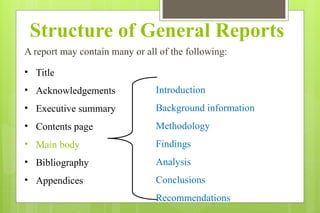Report Writing-Communicative English (B.Sc Nursing
- 2. What is a report? ’ü▒ Reports are oral, written or audio-taped exchanges of information between caregivers
- 3. Purpose Of Reporting ’éøCommunication ’éøLegal documentation ’éøFinancial billing ’éøEducation ’éøResearch ’éøAuditing-monitoring
- 5. Types of Report ’ü▒ Product report ’ü▒ Business report ’ü▒ Lab report ’ü▒ Technical report ’ü▒ Case study report ’ü▒ Research report (inc. dissertations) etc.
- 6. Reports Made By Nurses ’éøChange-of-shift reports ’éøTelephone reports ’éøTransfer reports ’éøIncident reports
- 7. Structure of General Reports A report may contain many or all of the following: ŌĆó Title ŌĆó Acknowledgements ŌĆó Executive summary ŌĆó Contents page ŌĆó Main body ŌĆó Bibliography ŌĆó Appendices Introduction Background information Methodology Findings Analysis Conclusions Recommendations
- 8. Preparatory Steps To Writing Reports ’éøIdentifying the purpose and scope ’éøKnowing the audience ’éøGathering Information ’éøOrganizing the Data ’éøSketching out an Outline ’éøPresenting the Visuals
Editor's Notes
- COMMUNICATION The record is a means by which the health care team members communicate health needs and progress, individual therapies, content of conferences, client education and discharge planning . The plan of care needs to be clear to anyone reading the chat. ┬Ā LEGAL DOCUMENTATION Accurate documentation is one of the best defenses for legal claims associated with nursing care. Nurses need to be indicate all assessments, interventions, client responses, instructions and referrals in the medical record. It safeguards the patient, nurses, doctors and hospitals ┬Ā FINANCIAL BILLING Medical records are audited to review financial charges used in the clientŌĆÖs care. EEDUCATION Records help the medical and nursing students in their clinical experience and provide data for care studies. RESEARCH Records serve as a reference material for research works. AUDITING AND MONITORING Nurse monitor or review records through- out the year to determine the degree to which quality improvement standards are met. Deficiencies identified are shared with all members of nursing staff so that corrections in practice can made.
- Factual A record must contain descriptive, objective information about what the nurse sees, hears, feels and smells. The use of vague terms such as appears, seems, or apparently is not acceptable because these words suggests that the nurse is stating an opinion. Accurate The use of exact measurements establishes accuracy Documentation of concise data is clear and easy to understand Use standard abbreviations , symbols and systems of measurements Correct spelling demonstrates a level of competency and attention to detail 3. Complete The information within a record entry or report needs to be complete , containing appropriate and essential information. 4.Current Timely entries are essential in the clientŌĆÖs ongoing care. Most of the health care agencies keeps records near the clientŌĆÖs bedside for the immediate documentation of information 5 .Organized The nurse communicates in a logical order. 6. Confidentiality Nurses are legally and ethically obligated to keep information about clientŌĆÖs confidential. Nurses are responsible for protecting records from all unauthorized readers. The record is stored by the health care agency after treatment ends.
- Change- of-shift reports ┬Ā At the end of the each shift nurses reports information about their assigned clients to the nurses working on the next shift. The purpose of the report is to provide continuity of the care among the nurse who are caring for a client. A change of shift may be given orally in person , audiotape recording or during ŌĆśwalking planningŌĆÖ rounds at each clientŌĆÖs bedside Oral reports are given in conference rooms with a staff members from both shifts participating, an advantage of oral reports is that it allows staff members to ask questions or clarify explanations. An audio-taped report is given by the nurse who completed care for the client and is left for the nurse on the next shift to review. Data about clients need to be objective current and concise. To prepare for the report, the nurse gathers information from work sheets, the clientŌĆÖs record and the clients care plan. ┬Ā 2. Telephone reports Nurse inform physician of changes in a clientŌĆÖs condition and communicate information to nurses on other units about transfer. Persons involved with a telephone report also must provide clear, accurate and concise information. To document a phone call [write TO- telephone order or VO- verbal order] nurse includes ŌĆōwhen the call was made Who made it Who was called To whom information was given What information was given What information was received A telephone order involves a physician stating a prescribed therapy over the phone to a registered nurse. A verbal order may be accepted when there is no opportunity for a physician to write the order, as in emergency situation. 3. Transfer Reports Clients may transfer from one unit to another to receive different levels of care .Transfer reports may be given by phone o in person .when giving a transfer report nurses include the following information. ClientŌĆÖs name, age, primary physician and medical diagnosis. Summary of progress up to the time of transfer Current health status Allergies Emergency code status Family support Current nursing diagnosis. Any critical assessments. Ned for any special equipment. 4. Incident Reports An incident is any event that is not consistent with the routine operation of a health care unit or routine care of a client. Examples of incidents include client falls, needle stick injuries, a visitor having symptoms of illness, medication administration errors, and accidental omission of ordered therapies.









